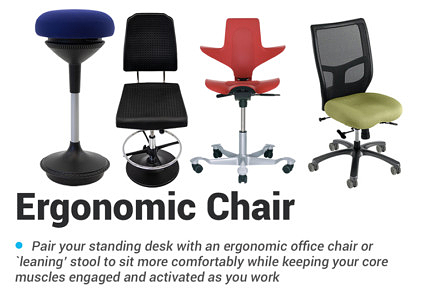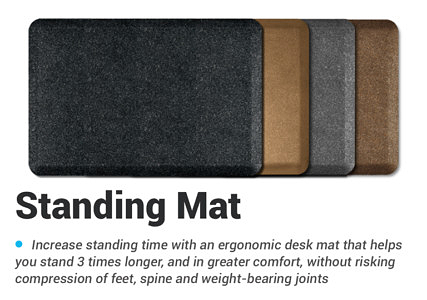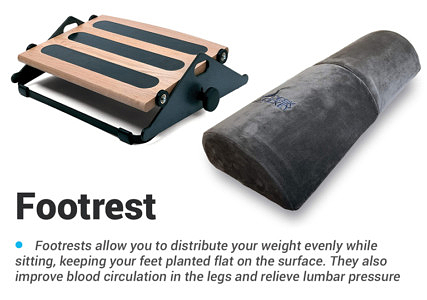Movemate Active Standing Board Review
- Lab tested
Like most reviews sites, our editorial staff and laboratory testing expenses are partially offset by earning small commissions (at no cost to you) when you purchase something through those links. Learn More

Overview
| Review Summary |
The Movemate Active Standing Board finds itself in the nascent new category of “ergonomic” balance boards, along with the Gymba muscle activation board. It mimics natural fluid movements and has a great range of motion in a variety of controlled movements that can really help people keep moving while they work at a standing desk. Quality, made-in-Canada construction using authentic Baltic birch. The only real downsides are the high price and the damage it can possibly do to some sensitive floors. Limited lifetime warranty expresses the company’s confidence in their strong materials, sturdy build, and patent-pending design. |
|---|---|
| MSRP / List Price | $449 |
| Shipping |
The product ships from Canada to US with subsidized shipping options ranging from $25 to $30 depending on destination. |
| Warranty |
Lifetime |
| Colors Available |
Natural wood |
| Construction |
Baltic birch |
| Weight Capacity |
400 lbs |
| Dimensions |
26.5″ L x 11.1″ W x 2.75″ H |
| Product Weight |
12 lbs |
| Competition | Top-Rated Balance Boards |
| Where to buy |
Buy on Movemate |
Rating
| Ease of Assembly | |
|---|---|
| Stability | |
| Safety | |
| Reliability | |
| Customer Experience | |
| Quality and Aesthetics | |
| Ergonomics | |
| Innovation | |
| Value | |
| Positives | The Movemate provides a large range of motion and a variety of movements that can be used at a standing desk or on a break around the office. One of few ergonomic balance boards that can be effectively used while actually working at a standing desk. Dynamic motion in the design with multiple independent slats promotes natural fluid movement patterns that also massage your feet when used with socks or barefoot. Physical therapy uses add even more value when not being used at a standing desk. Made in Canada quality construction with strong Baltic birch componentry. Movemate offers a Limited Lifetime Warranty and there's a 30-day full refund, money-back guarantee if it turns out not to be your jam. |
| Negatives | High price may present a barrier to some shoppers. Only one style option. Unlike balance boards, dynamic fulcrum helps spread pressure to prevent damage on scratch prone flooring, but protective layer recommended depending on usage intensity, which could be a problem on sensitive floors. People with chronic plantar fasciitis and orthotics might find it uncomfortable to use it without shoes and therefore may not reap 100% of the benefits of the independent slat movements. |
Bottom Line
Movemate Joins the Gymba in Ergonomic Balance Boards
When it comes to balance boards, most of them are made in such a way that the user has to focus significantly on balancing. Because of this, they aren’t all that easy to use while actually working at a standing desk. For a long time, the Gymba has been the only balance board we have found that provides the right balance of stability and movement to keep someone moving at a standing desk while allowing them to focus on work. We’ve been waiting for more products to appear in this category, and the Movemate Active Standing Board delivers.

We always encourage the greatest range of motion possible while working long hours at a computer, which is why we focus so much on walking treadmills for standing desks. The Movemate allows people to tap into dynamic movements, while remaining in control to match their task (i.e., switching easily between active movements during meetings/calls, and passive/no movement while typing). This allows users to add movement to their workday, without disrupting workflow, getting people one step closer to a “poor man’s treadmill desk.”
In this review we’re going to also summarize the key differences between the MoveMate and the Gymba, to help readers determine whether the extra cost of the Movemate will be worth it for them.
Can you really work while using this balance board?
At first glance, the Movemate seems to be the same shape as other balance boards that require the user to balance on a single point of contact with the floor that requires constant adjustment and focus to stay horizontal. However, the curve on the bottom of the movemate is much more shallow than other balance boards, with more contact on the floor to make standing still nearly as easy as doing so directly on the ground. Maybe not quite as easy as the Gymba, but much more than most other balance boards that are targeted at standing desk users.
Perhaps the most valuable movement that the Movemate is capable of, at least for standing desk users, is a dynamic motion that allows the feet to tip forward or back opposite of one another. This facilitates a kind of walking-in-place motion that some users can get pretty proficient at. This feature truly puts it side by side with the Gymba for consideration.

Because the Movemate essentially has an inverted dome beneath, it can also be used to make full torso twisting motions, albeit not while typing, but similar to how the Fluidstance Level or Uplift Motion-X Board do. However, just using the Movemate to rock back and forth, some of our testers managed to “walk” the board a bit forwards and backwards from their starting position over time. They then had to readjust slightly to get back in their optimal working position, which they could do by literally “walking it back.” Not a huge deal, but something that’s inherent to the design of this particular board. In contrast, the Gymba is unlikely to move around unintentionally because it makes more complete contact with the ground and doesn’t rest on an inverted dome.
Depending on your current level of physical activity, using the Movemate actively with its full movement range can be tiring because it is dynamically engaging your muscles and joints. This is a positive sign of meaningful muscle activation, and it is recommended to start with 20-30 minute sessions and build strength and stamina gradually. With that said, the generally best practice is to shift your postures throughout your workday and find a healthy balance between sitting, standing and moving. Additionally, as with any new physical activity regime, it is wise to ease in and listen to your body.
The basic qualification to be NEAT™ certified by the Mayo Clinic is that an ergonomic device must be able to raise the user’s basal metabolic rate by at least 10%. Standing at a sit-stand desk already accomplishes this much. But with the range of movement possible on the Movemate or a Gymba you’ll be able to well exceed that before getting into cardio heart rates, get too tired, and have to take a break.
Movemate’s patent-pending flex design allows the slats to mold to the feet so people can move naturally without thinking about it. Every action on the board has an equal and opposite reaction. This keeps people moving in a fluid, yet balanced manner, without having to think or remember to move. All it takes is one foot to move, and the other responds – which prompts yet another move – creating an intuitive, fluid, and rhythmic movement pattern. Although the board’s design encourages consecutive motions, you are still in full control so you can dictate your pace to suit your needs.
The most dynamic kinds of movement possible with this balance board aren’t compatible with using it while typing at the computer. These movements are ideal, however, for when taking a bit of a break from your work tasks, like twisting, squatting, and more. We’ll be adding many examples of this extracurricular activity, including video demonstrations, to our Complete Guide to Balance Board Exercises.
Different ways to use Movemate
There are a lot of ways you can use the cleverly-designed Movemate Active Standing Board. One important thing to keep in mind while using it is to listen to your body. Some people will only need minimal movements while others might be able to employ more muscles with greater movement range.
One convenient feature is markers on the wooden slats that help you place your feet in balance positions at a glance. Movemate features three primary stances, each allowing for varying ranges of motion and emphasizing different movement types. The wide stance enables a full range of flex and swing motion; the Mid stance enables a medium range of flex and swing motion; the Narrow stance enables a small range of flex and swing motion. Wider stances emphasize the flex and swing motions, while narrower stances emphasize the rocking motion. Rather than picking a stance, the recommendation is to use shoulder width or the wider stance as your default and then alternate between stances and explore different foot placements as you find what moves you best.
In comparison, Gymba users are limited to a single narrow stance.
An interesting aspect of the Movemate is that you can safely use it with or without footwear. They recommend just stepping on with your socks or barefoot so the individual slats of wood can conform to the shape of your foot. Several test subjects in our evaluation lab said it felt like a foot massage while rocking back and forth or rolling feet across from front to back. This is definitely a feature that the Gymba lacks because of its more controlled, linear motion.
On the other hand, if someone has chronic plantar fasciitis – meaning they must wear orthotics at all times and therefore must be wearing shoes – this aspect of the Movemate’s design is of no benefit. It would be quite painful to stand on barefooted or in socks with your full weight and no cushioning.
The Movemate can be used in a wide variety of ways. We have already addressed the classic rocking, simulated walking, foot massage, and twisting. Add to that easy toe fidgeting if you need to focus even more, stretching muscles and joints, increasing propriosceptor stimulation in the foot’s many bone joints, and more. This balance board is one of the most versatile pieces of ergonomic office equipment we have ever tested. One reviewer even turned it over and used it as a back stretcher, though the hard wooden surface is a bit less comfortable to use than the Gymba’s carpeted underside.

An interesting use of the Movemate is in physical therapy. There are physical therapists and chiropractors in Movemate’s hometown of Toronto enthusiastically using these balance boards to help their patients improve joint and muscle movement and healing.
Construction
How the Movemate is designed is critical to how it works. The slats are made of Baltic birch, which is one of the strongest wood materials you can build with (learn more about this amazing engineered wood product in our round-up of Baltic Birch Standing Desks). Naturally, being such a luxury material, that is going to increase the price of the final product. Price is clearly one of the biggest deterrents for purchasing the Movemate active standing board, at least for most people.

Currently, being made of the Baltic birch, it makes the board a bit heavier than other balance boards, especially the super lightweight (but impressively strong) Gymba. However, this added weight helps to boost the stability of the Movemate when in use. The Movemate has a slight cutout on the underside of the board that functions as a handle that makes it a bit easier to lift the unit up under your arm and carry away.
Movemate’s Limited Lifetime Warranty guarantees the product to be without manufacturing defects for life in recommended indoor use.
Using on Different Surfaces
The contact the Movemate balance board makes with the ground s much better than a lot of the competition out there that brings all of the user’s body weight down on a single pressure point. The Movemate spreads that weight out a more, due to its dynamic fulcrum, than most competitors, but still creates pressure on the floor surface. As with any piece of office equipment, it may be a good idea to have a protective layer underneath the board – especially with highly sensitive floors. However the design of the board inherently helps to prevent any flooring damage.
Do you want Movemate or Gymba?

If you need to figure out whether to buy a Movemate (made in Toronto) or a Gymba (made in Helsinki, distributed by iMovR in North America), and the points above haven’t swayed you one way or another, here are a few more.
If it comes down just to price, the Gymba is the way to go if it fills your needs in an ergonomic balance board with “walking in place” capability, and the ability to stop moving when you need to, but without having to dismount or just tilt to one side.
Direct comparison of the range of motion in the two balance boards is heavy on the side of Movemate, especially if you place your feet on the outer edges. This greater range of motion is due to two factors: the greater overall width of the board and the independent movement of the birch slats. It can also rotate and twist for an even larger variety of movements than they Gymba and all other balance boards we have seen. So, if this is the primary aspect you are looking for, the Movemate is the way to go.
If you want to match a style in your office, the Gymba offers more color options, seven in all. Currently the Movemate comes in one color, an unstained natural Baltic birch. Additionally, the eco-friendly ultra matte finish on the wood lets you see the natural grain of the wood and helps protect the wood from damage during regular use as it is the same grade of finishing used on high foot traffic flooring.
If you are worried about damaging your floors, the safer route is to go with the Gymba. It has a carpeted underside and larger contact area with the floor. If you have something to put between the Movemate and your floor, it could work fine for you but just keep in mind that anything too thick or soft may impede the ease of movement of the Movemate, especially in rotation around the center of the board. Note that from our testing and research, the Movemate has yet to cause visible damage, so the issue isn’t glaring. Our experience in the product category shows that using a protective layer will keep sensitive flooring safer when using a balance board that can rock in all directions.
The Gymba has gone through formal laboratory durability testing and been in the market since 2015, showing evidence that it is easy to keep clean and offers long-lasting durability, however it is built with baltic birch (one of the strongest materials), a solid stainless steel rod, and military-grade bungee cord. The Movemate hasn’t gone through quite as much testing outside of their own offices and doesn’t have a long track record of its durability yet. Though it does seem like common sense that keeping plastic clean and dry with the Gymba is easier than with the wood and internal connections of the Movemate. But that doesn’t mean we are understating the quality of Movemate’s construction, which is top-notch for what it is. And the limited lifetime warranty offers a great support for the Movemate’s durability.
Gymba can only be used with shoes on, where as Movemate gives you the freedom to use it with shoes, socks, or barefoot – allowing for a rolling massage in the latter two, that is if you are in an office where you can take off your shoes.
Both the Gymba and the Movemate provide a good degree of proprioceptor stimulation, similar to the benefit of stand on a 100% polyurethane anti-fatigue mat like the EcoLast. But the Movemate conveys this benefit to a greater degree. The long term implication of improved nerve stimulation in the many bones of your feet is improved balance, especially for older individuals that have already started seeing their balance erode after years of walking on flat floors in flat shoes. Using one of these fancy motion boards confers the very same benefits of walking on uneven terrain (as expounded upon in the bestseller Born to Run: A Hidden Tribe, Superathletes, and the Greatest Race the World Has Never Seen). We are huge fans of this under-recognized benefit.
To tap into the additional dynamic movement benefits of Movemate, as opposed to Gymba, you have to think about it more, taking brain cycles away from working. Using it like that is much easier and beneficial when consuming content—such as when listening in on a Zoom call—but you’re going to want to at least adjust to smaller movements that require less attention from your brain when it’s your turn to speak, or when you need to take notes.
One difference between the boards is the ways in which you get the full benefits of its dynamic movement. The Gymba needs to be turned over to do some extra stretches and ankle movement. The Movemate can give you several of those same benefits from the topside. Again, check out our comprehensive Complete Guide to Balance Board Exercises to make sure you get the most bang for your buck, regardless of which balance board you end up acquiring.
If you have a wider stance, the Movemate will be more comfortable because of its wider construction. Additionally, Movemate allows you to alternate between wide, mid and narrow stances in order to relieve strain, gain more variety muscle activation and access various movement types. On the other hand, Gymba only has a single narrow stance. That is one thing we would like to see from Gymba in the future.
If you want to learn more about the different kinds of balance boards out there, check out our round-ups of the best balance boards, rocker boards, wobble boards and balance trainers.






5 Comments
Leave a response >